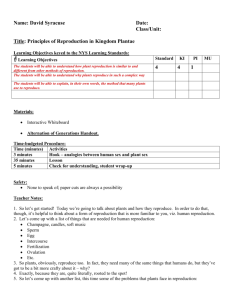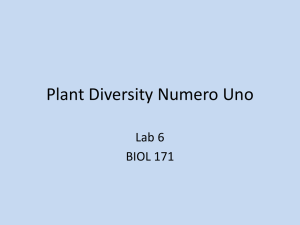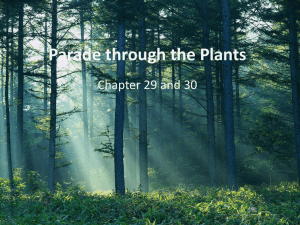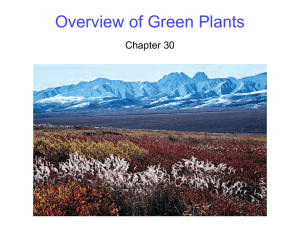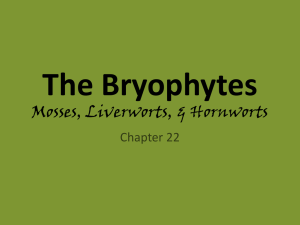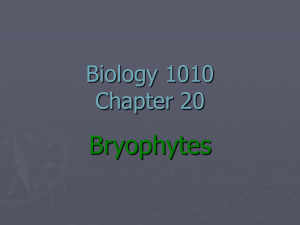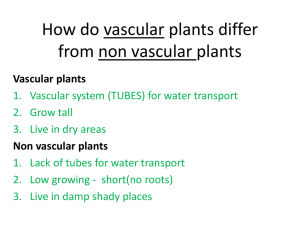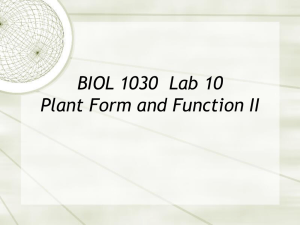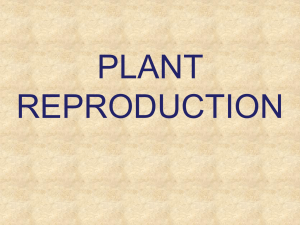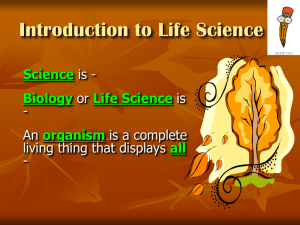Alteration of Generations, bryophyte, fern - MAH-SBHS
advertisement
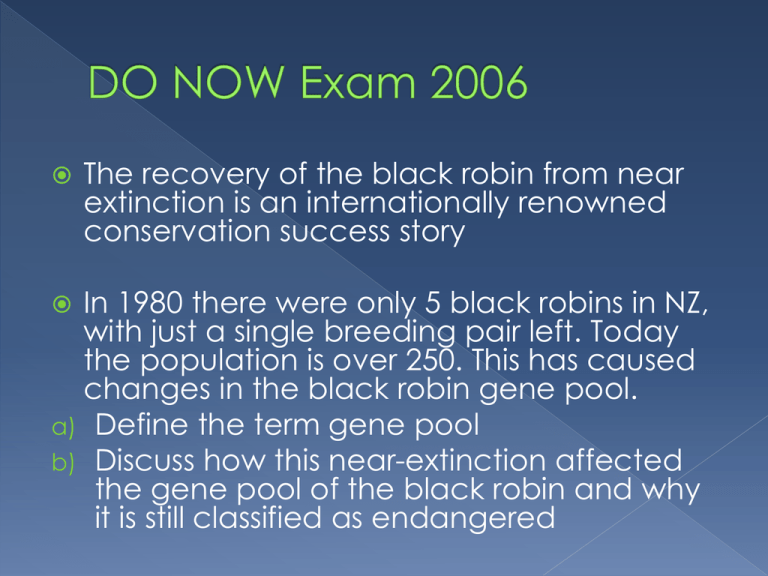
The recovery of the black robin from near extinction is an internationally renowned conservation success story In 1980 there were only 5 black robins in NZ, with just a single breeding pair left. Today the population is over 250. This has caused changes in the black robin gene pool. a) Define the term gene pool b) Discuss how this near-extinction affected the gene pool of the black robin and why it is still classified as endangered Explain how enzymes function as catalysts Enzyme activity may be affected by Temperature pH Co-factor/co-enzymes Inhibitors Discuss how enzyme activity is affected by these factors › › › › Describe the structure of the cell membrane. You may use labelled diagrams in your answer Discuss the importance of the cell membrane in maintaining a constant internal environment for the cell Name two organelles that plants have that animals do not and their function Define founder effect How three taxonomic groups of plants reproduce Compare and contrast the three types Describe how the plants are adapted for their environment in relation to reproduction Vegetative reproduction (asexual) › Low metabolic cost to the plant › Allows efficient exploitation of the resources in the environment › Does not promote genetic diversity › Environmental change and pathogens present risks Sexual reproduction: › › › › Promotes genetic diversity in a population Involves the alternation of generations High metabolic cost to the plant Allows species survival in changing environment …is the biological process by which new individual organisms are produced. Genes are passed on to the next generation, which ensures continuation of the species Variation in plants exists from sexual reproduction › INVOLVES AN ALTERNATION OF GENERATIONS Involves a haploid stage (n) called gametophyte (gamete producing plant) Involves a diploid stage (2n) called a sporophyte (spore-producing plant) Sexual reproduction occurs in all types of plants Involves the “alternation of generations” Definitions: › Sporophyte = diploid or 2n stage, produces spores by meiosis › Gametophyte = haploid or n stage, produces gametes by mitosis › Spore = haploid structure that develops directly into an organism (the gametophyte) › Gamete = haploid structure that fuses through fertilisation to produce a diploid zygote (the sporophyte) fuses through fertilisation to produce a diploid zygote that develop directly into an organism (the gametophyte) To do: Stick in the handout and fill in the words Explain in your own words what is happening A minute, typically one-celled, reproductive unit capable of giving rise to a new individual without sexual fusion, characteristic of lower plants, fungi, and protozoans (in a plant exhibiting alternation of generations) A haploid reproductive cell that gives rise to a gametophyte 1. Bryophytes Mosses, liverworts and hornworts. liverwort moss hornwort moss Lack water gathering roots and specialised vascular tissues for transport Usually less than 15cm in height but may sprawl over a considerable area Absorb moisture and minerals through above ground structures via diffusion and therefore grow in moist environments They do not have roots as such however they are anchored to the substrate they grow in by rhizoids They have small leaf like structures however they lack the specialised tissues of the true leaf and are only one to a few cells thick. The body of the plant is designed for storage and support The gametophyte phase dominates Gametes are produced by mitosis in structures called the antheridium (male) and archegonium (female) Bi-flagellate sperm are released by the antheridium that swim to the archegonium in the process of fertilisation [No water = No reproduction] The zygote develops into a sporophyte phase that is often totally dependent on the gametophyte for nutrition The sporophyte consists of a foot, stalk and single sporangium that produces and spreads spores by meiosis What is the name of the structure that produces sperm on the male gametophyte of mosses? Describe two ways in which bryophytes are dependent on liquid water If you looked at the chromosome numbers of what looked like a complete small moss plant, which part would be diploid and which part haploid? Structure Function Bi-flagellate sperm Allows sperm to swim from antheridium to archegonium to achieve fertilisation Sporangia of sporophyte raised into the air Archegonia produce chemical signals for sperm Sporangia explosively discharge spores Sporophyte grows on the gametophyte Structure Function Bi-flagellate sperm Allows sperm to swim from antheridium to archegonium to achieve fertilisation Sporangia of sporophyte raised into the air Ensures efficient dispersal of spores Archegonia produce Allows sperm to home in on the chemical signals for sperm correct location for fertilisation Sporangia explosively discharge spores Ensures efficient dispersal of spores Sporophyte grows on the gametophyte Sporophyte does not need to be independent or photosynthesise In groups of 3 › Use the play dough to ‘model’ the bryophyte life cycle › You will need to be able to explain it to another group Include the structures etc.. What is a bryophyte? Define gametophyte and sporophyte? What is the cytoplasm? Ferns are vascular plants that can grow much larger than bryophytes Presence of vascular system allows internal transport of water and food Leaves (fronds) are made up of leaflets (pinnae), efficiently capturing light, ferns are often found in lower levels of a forest Leaves are composed of a variety of different cell types Spores give rise to bisexual gametophytes. The spores develop into a flat membranous type structure with rhizoids. The antheridia and archegonia grow on the underside. The gametophyte contains both the male and female parts (The male part = the antheridia and the female part = archegonia). (ie male and female parts on the same gametophyte) The antheridia and archegonia mature at different times ensuring cross fertilisation. Flagellated sperm are produced by the antheridia and therefore requiring water for fertilisation Fertilisation occurs in the archegonia and development of the sporophyte also occurs here. Initially the sporophyte receives nutrients form the gametophyte however, it soon becomes photosynthetically independent. Once the sporophyte is independent, the gametophyte disintegrates Diagram also pg. 298 (Bayley) Once finished you will need to collect a rearrange sentences sheet from Mrs H Then draw a table that outlines similarities and differences between the reproduction of moss and ferns Similar Different Require moist environment Water for fertilisation has to be present Ferns more complex Grow larger - Have vascular tissues Rhizoids present Bryophytes: Sporophyte is dependent on gametophyte for nutrients Gametophyte is dominant stage Alternation of generations Spores are produced Ferns: Sporophyte not dependent on gametophyte Sporophyte is the dominant stage Separate male and female gametophytes Dioecious refers to a plant population having separate male and female plants. Monoecious, an individual that has both male and female reproductive units on the same plant; What are they? Flower Structure Male and Female Gametes Reproductive cycle Angiosperms (flowering plants) are the most abundant and successful plant group 300,000 different species counted so far Vascular plants with a wide range of sizes, adaptations and habitats Angiosperms are the final improvement on plant reproduction; They grow their seeds inside an ovary; The ovary is embedded inside a flower; After fertilisation the flower falls away and the ovary swells to become a fruit. Angiosperm sporophytes produce unique reproductive structures called flowers Flowers consist of four types of highly modified leaves › › › › Sepals Petals Stamen Pistil (or carpel) Their site of attachment to the stem is the receptacle Reproduction and Development Reproduction and Development Copy diagram on the board and reasons for the changes Sepals and petals are nonreproductive organs › Sepals – protect the other three, the floral bud › Petals – attract pollinators and act as “landing pads” Reproduction and Development Anthers and carpels are male and female reproductive organs, respectively › Anther – consists of filament (long, thin) and anther (pollen) › Carpel – consists of stigma (sticky opening), style (long tube connecting stigma to ovary), ovary (houses ovules; becomes fruit), and ovules (develops female gametes; become seeds) › COPY DIAGRAMS ON BOARD Reproduction and Development Complete flowers – have all four floral organs › Ex: Trillium Incomplete flowers – missing one or more of the four floral organs Reproduction and Development Bisexual flower (perfect flower) is equipped with both stamens and carpals › All complete and many incomplete flowers are bisexual A unisexual flower is missing either stamens (carpellate flower) or carpels (staminate flower) Reproduction and Development Monoecious plants: staminate and carpellate flowers at separate locations on the same individual plant › Ex: corn ears derived from clusters of carpellate flowers; tassels consist of staminate flowers Reproduction and Development Dioecious plants: staminate and carpellate flowers on separate plants › Ex: Date palms and Sagittaria (below) have carpellate individuals that produce dates and staminate individuals that produce pollen Reproduction and Development http://www.youtube.com/watch?v=bUj VHUf4d1I http://users.rcn.com/jkimball.ma.ultranet /BiologyPages/A/Angiosperm.html Sporophyte generation dominates Reproduction is independent of water Reproduction requires pollen transfer to the stigma, usually by wind or animal pollinators Reproduction involves a “double fertilisation” Reproduction is made more effective by using seeds to distribute embryonic plants Gametophyte generation reduced to small number of cells that are dependent on the sporophyte Insects Birds Snails Wasps Bats Wind Self vs cross pollination Seed dispersal occurs by: › Wind (e.g. dandelion, sycamore) › Water › Animals (e.g. succulent fruit, hooked fruit) › Explosive methods (e.g. legumes) Complete the exercises on page 258, Biozone Pollination is the transfer of pollen from the anther to the stigma, usually by wind or animals Use pages 292-294 to answer these questions: › What are the major differences between wind and animal pollinated flowers? › How do flowering plants ensure they do not self fertilise? › What is the difference between pollination and fertilisation? › Describe the events between pollination and fertilisation, what has to happen? What is the “double fertilisation?” The new sporophyte in angiosperms is packaged into a seed for dispersal Use pages 294-297 to answer these questions: › What is a fruit? What part of the flower develops into the fruit › › › › › and the seed? What is the difference between a monocotyledon seed and a dicotyledon seed? Draw a labelled diagram of a typical seed, along with the labels and their functions What are the main mechanisms for dispersing seeds? What are the factors required for seed germination? What advantage do angiosperms have over mosses and ferns by producing fruit and seeds? Germination requires the following factors: › Oxygen › Water › Correct temperature Germination involves re-starting the metabolism of the seed Photosynthesis only occurs when chlorophyll is produced in new leaves in the emerging shoot Prepare a table comparing mosses, ferns and angiosperms for the following features: › › › › › Dominant generation Which generation is dependent on the other Requirements for water in reproduction Environments that the plant can live in Methods to avoid self-fertilisation Prepare simple diagrams, with labels, showing the reproductive cycles of the three plant groups Begin linking structures and functions to the plant and its lifestyle that can be used in an essay question
